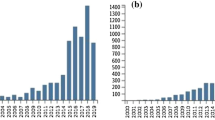Abstract
Collaborative networked organizations (CNOs) are complex entities whose proper understanding, design, implementation, and management require the integration of different modeling perspectives. A large number of modeling tools and theories that have been developed in other disciplines have a potential applicability in this domain. Therefore, an identification of the most promising approaches is made and mapped into four dimensions of an endogenous perspective of collaborative networked organizations: structural, componential, functional, and behavioral. But a comprehensive modeling of such complex dynamic systems requires also an exogenous perspective, the life cycle dimension, and a stratification of models according to the modeling purpose. Thus a comprehensive modeling framework is therefore proposed as a first step towards the elaboration of a reference model for collaborative networks.
Similar content being viewed by others
References
Afsarmanesh, H., & Camarinha-Matos, L. M. (2005). A framework for management of virtual organizations breeding environments. Collaborative networks and their breeding environments. Boston: Springer
Alexander P. (1996). Best of both worlds: Combining formal and semi-formal methods in software engineering. Potentials, IEEE 14(5):29–32
Bowen J. P., Hinchey M. G. (2006). Ten commandments of formal methods... ten years later. Computer 39(1):40–48
Camarinha-Matos, L. M., & Abreu, A. (2003). Towards a foundation for virtual organizations. In Proceedings of business excellence 2003 –int. conf. performance measures, bench-marking, and best practices in new economy. Guimarães, Portugal, 10–13 Jun 2003
Camarinha-Matos, L. M., & Afsarmanesh, H. (2004). Formal modeling methods for collaborative networks. Collaborative networked organizations – a research agenda for emerging business models, cap. 6.3, Springer, Boston
Camarinha-Matos, L. M., & Afsarmanesh, H. (2006a). A modeling framework for collaborative networked organizations, Network-centric collaboration and supporting frameworks, IFIP (Vol. 224). Boston: Springer
Camarinha-Matos, L. M., & Afsarmanesh, H. (2006b). Towards a reference model for collaborative networked organizations. Information technology for balanced manufacturing systems, IFIP (Vol. 220). Boston: Springer
EGA, Enterprise Grid Alliance Reference Model, 13 Apr 2005. http://www.gridalliance.org/en/workgroups/ReferenceModel.asp
Eschenbaecher J., Ellmann S. (2003). Foundation for networking: A theoretical view on the virtual organization, in processes and foundations for virtual organizations. Boston, Kluwer
FEA. FEA Consolidated Reference Model, May 2005, http://www.whitehouse.gov/omb/egov/documents/CRM.PDF.
George, V., & Vaughn, R. (2003). Application of lightweight formal methods in requirement engineering. CrossTALK - The Journal of Defense Software Engineering, 16, 30
Huan S. H. (2004). A review and analysis of supply chain operations reference (SCOR) model. Supply Chain Management: An International Journal 9(1):23–29
IFIP-IFAC TFAEI, GERAM. (2003). The generalized enterprise reference architecture and methodology, IFIP-IFAC task force on architectures for enterprise integration. In P. Bernus, L. Nemes, & G. Schmidt (Eds.), Handbook on enterprise architecture. Heidelberg: Springer
Liu, S. (2005). Formal engineering method for software development - an introduction to SOFL. Retrieved February, 2006, from the World Wide Web: http://cis.k.hosei.ac.jp/~sliu/FMlecture1.pdf.
Löh H., Zhang C., Katzy B. (2005). Modeling for virtual organizations, in virtual organizations – systems and practices. Boston, Springer
Noran, O. (2003). A mapping of individual architecture frameworks (GRAI, PERA, C4ISR, CIMOSA, ZACHMAN, ARIS) onto GERAM. In P. Bernus, L. Nemes, & G. Schmidt (Eds.), Handbook on enterprise architecture. Springer
Stewart G. (1997). Supply-chain operations reference model (SCOR): The first cross-industry framework for integrated supply-chain management. Logistics Information Management 10(2):62–67
Tolle M., Bernus P. (2003). Reference models supporting enterprise networks and virtual enterprises. International Journal of Networking and Virtual Organisations 2(1):2–15
Vernadat, F., & Kosanke, K. (1992). CIM-OSA: A reference architecture for CIM. In Proceedings of the IFIP TC5/WG5.3 eight international PROLAMAT conference on human aspects in computer integrated manufacturing, FIP Transactions; Vol. B-3, (North-Holland)
Williams T. J. (1994). The purdue enterprise reference architecture. Computers in Industry 24(2–3):141–158
Zachman J. A. (1987). A framework for information systems architecture. IBM Systems Journal 26(3):276–292
Author information
Authors and Affiliations
Corresponding author
Rights and permissions
About this article
Cite this article
Camarinha-Matos, L.M., Afsarmanesh, H. A comprehensive modeling framework for collaborative networked organizations. J Intell Manuf 18, 529–542 (2007). https://doi.org/10.1007/s10845-007-0063-3
Published:
Issue Date:
DOI: https://doi.org/10.1007/s10845-007-0063-3




